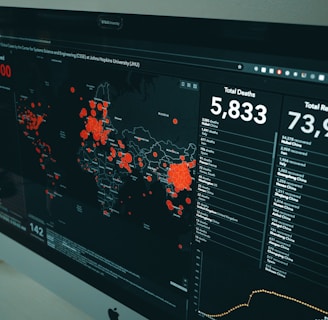
The Truth Behind EV's in British Columbia
Don't let the lies mislead you
INDUSTRY


Kick-off
When it comes to electric vehicles (EVs), there's a lot of mixed information out there. Some critics claim that EV uptake is on the decline, with people shying away from this trend. Recent news about Tesla laying off 10% of their workforce seems to support this view, leading some to believe that EV adoption is on the decline. However, this is certainly not the case in all regions, particularly not in British Columbia. This picturesque province is the leader in Canada in terms of EV adoption rates. Almost 20% of all new cars sold here are electric!
Let's delve into these fascinating statistics to understand what they mean. The champion is in the house!
The following information is primarily sourced from an article on the BC Hydro website. I've selected the most interesting points and elaborated on them. If you want to learn more, feel free to check out the original article.
Statistics as of January 2024
As of January 2024, British Columbia is home to a whopping 150,000 electric vehicles (EVs). This significant number is a testament to the province's commitment to sustainable transportation and its efforts to reduce greenhouse gas emissions. The growing popularity and adoption of EVs in BC reflect the shifting mindset of its residents towards eco-friendly alternatives, further solidifying the province's position as a leader in the EV revolution. This shift is also supported by the government's push for cleaner energy sources, and the increasing availability of charging infrastructure across the province. These factors have not only made EVs a feasible choice but also a preferred option for many British Columbians. Furthermore, the variety of EV models available in the market has made it easier for consumers to find one that suits their lifestyle and budget, contributing to the steady increase in EV numbers.
Number One Spot
British Columbia outshines all other regions in North America when it comes to embracing EVs. We proudly occupy the top spot for new EV sales as a percentage of total vehicle sales. We achieved a remarkable 18% of all new car sales last year, and the forecast for 2023 is that more than one fifth of all new vehicles sold will be electric.
High-Occupancy Vehicle (HOV) Lane Perks
Typically, to use the HOV lane, you need to have 2 passengers in your car. However, if you drive an EV, you can use the HOV lane at any time, even if you're driving alone. So, enjoy your ride!
Squamish Leading the Charge
In early 2023, Squamish took the lead in Canada for clean energy vehicle adoption, boasting a remarkable rate of 6.9 zero-emission vehicles (ZEVs) for every thousand residents. This noteworthy achievement reflects the community's commitment to sustainability and clean energy. Squamish's residents are clearly at the forefront of the green revolution, adopting electric vehicles at a pace that outstrips many other regions. It's a testament to the community's forward-thinking mindset and their active role in reducing carbon emissions. This trend in Squamish is certainly one to watch, as it sets a positive example for other towns and cities across the country.
Goodbye, Range Anxiety
Remember the fear of running out of charge? Now, there are at least 57 models of battery electric cars and trucks in B.C. offering at least 400 km of electric range. Moreover, there are 19 models that can travel 500 km or more between charges. The Rivian R1T dual-motor pickup leads the pack with a range of up to 661 km, slightly ahead of the Tesla Model S.
Renewable Energy Powering the Revolution
Renewable energy is the driving force behind B.C.'s EV revolution. With 98% of our electricity generated from renewable resources, clean and affordable electricity in B.C. makes the case for owning an EV here much stronger than in regions of North America that still rely on fossil fuels for electricity generation.
Superfast Charging on the Horizon
We've recently revealed plans to introduce superfast charging, at 180 kW, to our fast charging network. This will enable EV drivers with fast-charging capabilities to add 180 km of charge in just 10 minutes. Most of our fast charging stations provide 50 kW charging, which can usually charge most EVs up to 80% capacity in 40 minutes or less.
Future Goals
The Government of British Columbia has set ambitious goals for the adoption of zero-emission vehicles. The ultimate target is for 100% of new car sales in the province to be zero-emission vehicles by a yet-to-be-announced year. There are also several intermediate targets set to ensure progress towards this ultimate goal. By 2026, the aim is for 26% of new car sales to be zero-emission vehicles. This target will then significantly increase, with the intention for 90% of new car sales to be zero-emission vehicles by 2030. These targets showcase the government's commitment to environmental sustainability and reducing the province's carbon footprint.
Rebates
The Government of British Columbia has demonstrated its commitment to promoting electric vehicle use by allocating an impressive $6.59 million for EV charging rebates. These rebates are designed to ease the transition to electric vehicles for residents of the province by providing financial incentives. Not only are they accessible to homeowners, but they also extend to workplaces, condominiums, and townhouses. This broad coverage ensures that charging infrastructure can be widely established, making electric vehicle ownership more convenient and sustainable across various living and working environments.
Final Thoughts
In conclusion, the rise of electric vehicles in British Columbia is not just a trend, but a reflection of a societal shift towards sustainable and eco-friendly living. With the government's strong push for clean energy and a supportive infrastructure, British Columbia is leading the charge in North America's electric vehicle revolution. As more and more people embrace this change, the future of transportation in the province looks greener than ever. However, it's crucial to remember that this is just the start. We all have a role to play in achieving these ambitious goals for a cleaner, more sustainable future.




